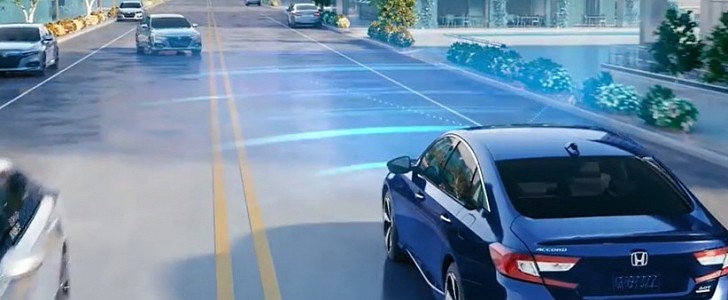Honda says Sensing 360, an omnidirectional safety and driver-assistive system, works to expand the “sensory range” around a vehicle and that it effectively wipes out blind spots around the vehicle.
With nearly 6 million cars on the road in the U.S. today fitted with Honda Sensing and AcuraWatch, Honda says global adoption of Honda Sensing 360 will begin in China in 2022 and will come as standard equipment on U.S. models by the year 2030.
Honda Global CEO, Toshihiro Mibe, says such safety advances reflect a global vision the company announced earlier this year, and that the end game is to put a stop to traffic collision fatalities involving Honda motorcycles and automobiles by 2050.
The company introduced Honda Sensing in the 2015 Honda CR-V and AcuraWatch in the 2015 Acura TLX.
Gary Robinson Assistant VP of Product Planning at American Honda Motor Co., says Honda Sensing 360 is the next major step in what he called “an industry-leading application of safety and driver-assistive technologies."
This Honda suite of technologies has continued to evolve, and the company says the new Honda Sensing 360 is a further advancement in their capabilities. This latest iteration includes an omnidirectional sensory range that includes inputs from five advanced, millimeter-wave radar units placed around the vehicle. The system also includes a monocular camera similar to one in use by current Honda Sensing systems.
In their efforts to create a “collision-free society,” Honda operates two of the world’s most sophisticated crash-test facilities in Ohio and Japan.
Advanced passive safety technologies from Honda include the proprietary Advanced Compatibility Engineering body structure and next-generation passenger front airbag technology. Both are designed to provide collision protection for occupants. Honda says the tech is designed to reduce the frequency and severity of collisions while serving as a “technological and perceptual bridge” to a future that includes highly automated vehicles for the future.
Honda Global CEO, Toshihiro Mibe, says such safety advances reflect a global vision the company announced earlier this year, and that the end game is to put a stop to traffic collision fatalities involving Honda motorcycles and automobiles by 2050.
The company introduced Honda Sensing in the 2015 Honda CR-V and AcuraWatch in the 2015 Acura TLX.
Gary Robinson Assistant VP of Product Planning at American Honda Motor Co., says Honda Sensing 360 is the next major step in what he called “an industry-leading application of safety and driver-assistive technologies."
This Honda suite of technologies has continued to evolve, and the company says the new Honda Sensing 360 is a further advancement in their capabilities. This latest iteration includes an omnidirectional sensory range that includes inputs from five advanced, millimeter-wave radar units placed around the vehicle. The system also includes a monocular camera similar to one in use by current Honda Sensing systems.
In their efforts to create a “collision-free society,” Honda operates two of the world’s most sophisticated crash-test facilities in Ohio and Japan.
Advanced passive safety technologies from Honda include the proprietary Advanced Compatibility Engineering body structure and next-generation passenger front airbag technology. Both are designed to provide collision protection for occupants. Honda says the tech is designed to reduce the frequency and severity of collisions while serving as a “technological and perceptual bridge” to a future that includes highly automated vehicles for the future.





